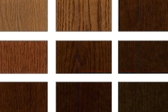
A number of different stains, paints and acrylic treatments can be applied to timber, both to improve the way it looks and to help to make it more resistant to weather and termites.

What are wood stains?
A wood stain is a pigmented liquid designed to soak into a timber and alter its colour. Wood stains apply a pigment and sealant to whatever wood they’re coating, protecting it from UV rays, weathering and general household wear and tear. Whether applied to drastically alter the colouring of a deck or cladding, or simply to protect it and keep it looking new, stains are available in a variety of different strengths which penetrate into the wood to a greater or lesser extent.
How do different types of stains differ?
Solid or opaque deck stains will provide the most pigmentation and therefore the most UV protection, but tend to not soak very far into the wood and can become flaky with time. These stains create the darkest colouration in the wood. The range moves through to semi-solid, semi-transparent and transparent, which provides the least UV protection, but allows the natural colouration of the wood to shine through and penetrates quite deeply into the wood as it is a thinner mixture. There are also some specialised paints and acrylic based coatings that can be used to waterproof your wood which can be especially useful in high rain areas or around pools and spas.
Over time, whatever type of stain you use will eventually weather and need to be resealed. It is critical to clean and prepare the deck correctly before you apply staining, so as to avoid patchiness and other issues. Sealers and stains typically require fewer applications per year than decking oils, so can be used cut down on maintenance time.
- Alters the colouration of the wood.
- Available in a variety of colour intensities from solid to transparent.
- Long lasting UV and weather protection.
Where can wood stains be used?
Stains and sealers can be used on decking, balustrades, stairs, infills, cladding or other wooden surface that is exposed to the weather. Applying the stains all at once will allow for consistency in colouration, and thicker or multiple coats will lead to darker tones. It is best to test on an offcut of the same type of timber if you have one available, or a small patch that won’t be visible. Allow it to dry properly and see if you are pleased with the results.
Wood stains are not suitable for use on wood plastic composite materials.
|
Advantages
|
Disadvantages
|





